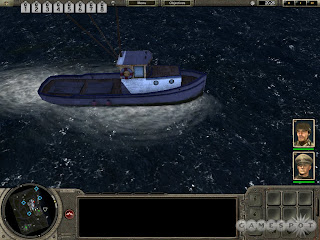The 1st phase has just began.
Review By Kael
Having already discarded two previous games by CDV, Cossacks and Blitzkrieg, I wasn't sure I wanted to give them another chance. But, having upgraded my computer, I was itching for a new game and I wanted a war game. Not an RPG, no shooters, not a sports game, just a good old fashioned war game, preferably with tanks. I had seen Code Name: Panzers – Phase One in the bargain bin and, knowing it was a new take on the Blitzkrieg series, I decided to give CDV one more attempt.
Needless to say, this is a vast improvement over the older Blitzkrieg series. Most, if not all, of the annoying things about Blitzkrieg have been discarded and replaced with things that make sense. The overall menu interface has been improved so that one can find and play the specific scenario you want. The graphics are a huge improvement (they do require a 64 bit graphics card), I can actually see my units and identify them. The game play interface is also improved by reducing and simplifying the icons used for certain functions. All in all, it is a much better game. Even my son agrees.
The overall premise is a tactical Real Time Strategy game with a hint of a Role Playing Game attached. You play as one of three named officers, a German, a Russian or an Anglo-American, in command of a core set of units. As you progress through the missions, your units gain experience as they fight and you gain prestige points. Hidden objectives can be found to increase your prestige points and give you in-game bonuses. Between missions, you can use your points to buy new units to add to your core, selling older units or upgrading them. It mostly works. If one of your core units is destroyed, it will be replaced, but it will lose all of its gained experience. If you are killed, of course, you lose.
Game play is pretty standard RTS fare. Click on a unit to highlight it and then click where you want it to move to or attack. An icon menu appears at the bottom of the screen with any special functions this unit can perform, but most are not needed on a routine basis. Hot Keys are also available. Units can be formed into groups for ease of control. You can set each unit's stance as aggressive, cautious or defensive. Air strikes and artillery are covered by the game system. Click the icon, click on the map where you want it to hit and shortly, your fire support will rain down. Medics, repair trucks and ammo trucks automatically fix any unit they are near, just move them close and the game system takes care of the rest. It is rather intuitive and makes for ease of play.
Again, the graphics are excellent. Tank turrets rotate and spew fire when they shoot. Trees and fences are knocked down when tanks plow over them. Houses are blown up and the explosions are quite realistic. The sound is good without being obtrusive. The game moves along at a pace that some may find too slow, but I thought it was just right. If you prefer, you can speed it up.
During movement, some units still have a tendency to wander off in a direction other than what you wanted. They will eventually get to the designated location, but they will sometimes take a route that is, shall we say, less than optimal. This requires a certain degree of micromanagement. This is the one real flaw in the game and it is relatively minor in most instances other than in urban areas.
The A.I. is not bad. Enemy units will come after you and attack, and then sometimes withdraw when they take a certain amount of damage, rather than wait around to be killed. Others will die in place. There are not, however, a lot of defensive missions for the player to perform. Too often, you have to lead with your chin to locate, close with and destroy the enemy.
The scenarios are definitely not easy. Most will require several play-thrus or a walkthrough to figure out the nuances and get a high score. The indirect approach seems to be the standard method of scenario design. Realistic tactics should be used to achieve your objective and preserve your core force for the next mission.
The German campaign ends during the advance to Stalingrad, about where the Russian campaign starts. The only problem with this is it is 1942 and the Tiger tank was not available until 1943. If you want to drive one of Professor Porsche's 60 ton King Tigers and “brew up” some Shermans, there is always skirmish mode, similar to random map in more traditional RTS games. Use a set number of prestige points to build your army and then go out and do battle against a human opponent on-line or the computer.
There does not appear to be a scenario generator or map maker utility to make your own scenarios, not that I would ever do that. Several additional maps are available for download from the CDV website if you so desire. Overall, this game probably points out at about an eight out of ten (maybe 8.5). It does what it advertises, it lets me move and shoot tanks at other tanks. It's fun to play with a good level of detail to the historical period. I recommend this game for war gaming enthusiasts.
NAME: CODENAME PANZERS - PHASE ONE
SYSTEM: PC











No comments:
Post a Comment